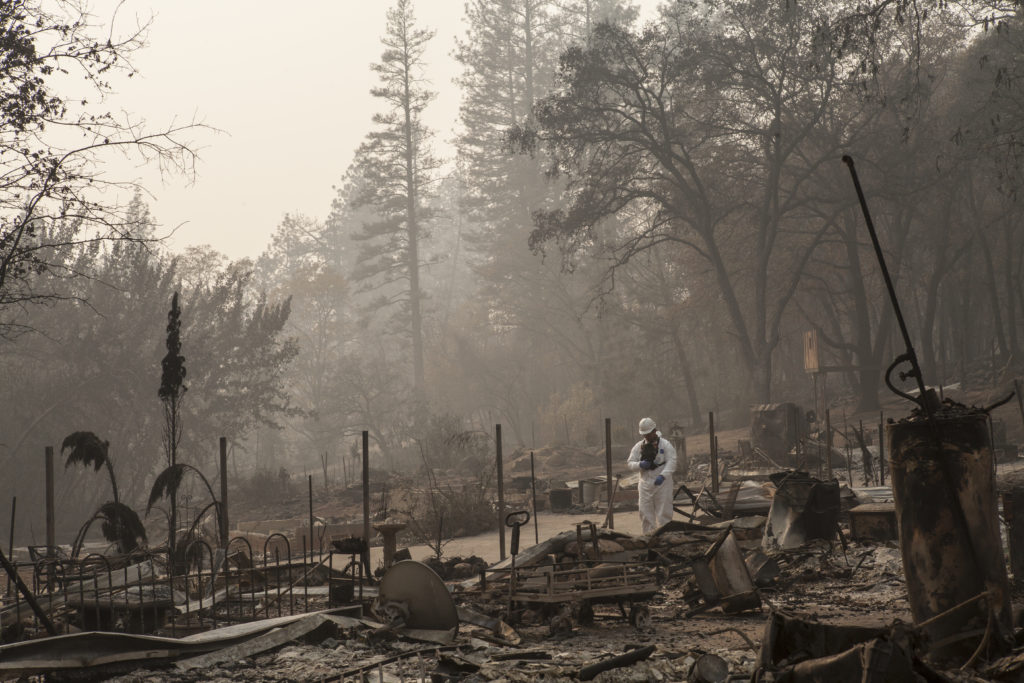
Do you have a story for us about natural disasters? We want to hear from you. Email us at rleven@publicintegrity.org.
Gregory Friendshuh, 77, ran into problems getting reimbursed after the Camp Fire in California, among last year’s most costly disasters worldwide. His mobile home in Paradise burned up — and so did the papers proving he owned it, which he and his wife had to leave behind in their frantic escape. That meant he couldn’t prove that where he lived existed. He said that he received federal aid, but not for the trailer.
“Who cares about a damn pink slip,” he told the Center for Public Integrity in February, referring to the incinerated title. “I lost my home.”
The fire came at an especially difficult time for him. Just a day and a half before, he had been discharged from the hospital after open-heart surgery. Smoke from the fire sent him right back. Weeks after recounting his experience, Friendshuh died.
Even when vulnerable people get disaster aid, it isn’t always equitable. After a 2008 Iowa flood, academics from the University of Iowa investigating purchases of damaged housing by local governments found areas with high elderly and Hispanic populations were less likely than applicants in other communities to receive pre-disaster market value for their homes. They also weren’t as likely to receive timely payments for those properties.
Individual injustices can have a major impact over time. A 2018 study looking at 15 years of U.S. disasters, written by sociologists from the University of Pittsburgh and Rice University in Texas, worked to understand those effects by examining property damage and wealth accumulation for roughly 3,400 American households. They found that whites tend to see an increase in wealth “the more natural hazard damages accrue in a county.” Blacks, by contrast, lose ground.
“How federal assistance is currently administered seems to be exacerbating rather than ameliorating wealth inequalities that unfold after costly natural hazards,” the researchers concluded.
The Federal Emergency Management Agency, which coordinates national disaster response and recovery, didn’t directly respond to the study’s findings. But spokeswoman Jessica Nalepa said in a statement that the agency doesn’t base its assistance decisions on demographic factors such as race or economic status.
“FEMA case workers do their absolute best to work with families after a disaster when many decisions are being made about recovery,” Nalepa said. “To imply that FEMA does not or would not grant assistance to any survivor in need is grossly inaccurate, misleading and disturbing.”
Terry, who is also a board member for a nonprofit disaster relief organization, the North Florida Inland Long-Term Recovery Group, praised the federal government’s response to Hurricane Michael. But she too has seen some residents struggle to get aid. They’ve had to “appeal, appeal, appeal,”she said. Often that means trying to find even more records proving ownership. Records that might have been lost in the storm. Records they may not have kept to begin with.
“Some people get tired of appealing, honestly,” Terry said.
‘Like nothing we had seen’
In an effort to do better, some government agencies are harnessing social vulnerability tools, like the University of South Carolina’s Social Vulnerability Index, as they plan and respond to disasters. South Carolina, for example, paired the index with federal damage data after Hurricane Matthew in 2016 to help distribute funds to those who needed it most.
Worsening disasters, meanwhile, are forcing groups who work with vulnerable individuals to think bigger. Julie Aguilar Rogado, deputy director for Legal Services of Northern California, said her office’s caseload rose roughly 200 percent following the Camp Fire, and they didn’t have enough people to address the need. Now they’re considering how to quickly mobilize all California legal aid offices for future disasters.
“The scale of the Camp Fire was like nothing we had seen in our service area before,” Rogado said.
Still, advocates and academics worry not enough is being done. The National Academies of Sciences, Engineering and Medicine, for example, have called for the government to fund studies and develop interventions to address disparate impacts on poor people caused by flooding hazards. And in April, U.S. Sen. Elizabeth Warren and Rep. Bennie G. Thompson urged a federal agency to investigate whether disaster relief is making inequality worse.
Some say the best solution is prevention. Change where people can live so they reside in less vulnerable areas. Reduce poverty levels so people have the resources to prepare. Limit greenhouse gas emissions to slow climate change.
That approach, said Dr. Irwin Redlener, director of Columbia University’s National Center for Disaster Preparedness, ensures “we’ve done everything possible to prevent these conditions in the first place.”
For More Information:
Do you believe you have been treated unfairly by the Federal Emergency Management Agency? FEMA asks you to call 800-621-3362 or 800-462-7585 (TTY/TDD).